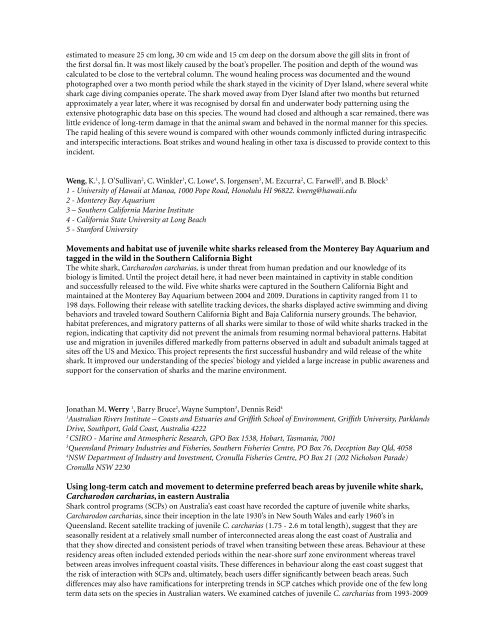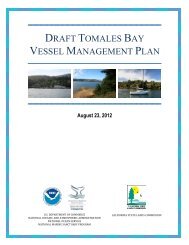Symposium program - Gulf of the Farallones National Marine ...
Symposium program - Gulf of the Farallones National Marine ...
Symposium program - Gulf of the Farallones National Marine ...
Create successful ePaper yourself
Turn your PDF publications into a flip-book with our unique Google optimized e-Paper software.
estimated to measure 25 cm long, 30 cm wide and 15 cm deep on <strong>the</strong> dorsum above <strong>the</strong> gill slits in front <strong>of</strong><br />
<strong>the</strong> first dorsal fin. It was most likely caused by <strong>the</strong> boat’s propeller. The position and depth <strong>of</strong> <strong>the</strong> wound was<br />
calculated to be close to <strong>the</strong> vertebral column. The wound healing process was documented and <strong>the</strong> wound<br />
photographed over a two month period while <strong>the</strong> shark stayed in <strong>the</strong> vicinity <strong>of</strong> Dyer Island, where several white<br />
shark cage diving companies operate. The shark moved away from Dyer Island after two months but returned<br />
approximately a year later, where it was recognised by dorsal fin and underwater body patterning using <strong>the</strong><br />
extensive photographic data base on this species. The wound had closed and although a scar remained, <strong>the</strong>re was<br />
little evidence <strong>of</strong> long-term damage in that <strong>the</strong> animal swam and behaved in <strong>the</strong> normal manner for this species.<br />
The rapid healing <strong>of</strong> this severe wound is compared with o<strong>the</strong>r wounds commonly inflicted during intraspecific<br />
and interspecific interactions. Boat strikes and wound healing in o<strong>the</strong>r taxa is discussed to provide context to this<br />
incident.<br />
Weng, K. 1 , J. O’Sullivan 2 , C. Winkler 3 , C. Lowe 4 , S. Jorgensen 5 , M. Ezcurra 2 , C. Farwell 2 , and B. Block 5<br />
1 - University <strong>of</strong> Hawaii at Manoa, 1000 Pope Road, Honolulu HI 96822. kweng@hawaii.edu<br />
2 - Monterey Bay Aquarium<br />
3 – Sou<strong>the</strong>rn California <strong>Marine</strong> Institute<br />
4 - California State University at Long Beach<br />
5 - Stanford University<br />
Movements and habitat use <strong>of</strong> juvenile white sharks released from <strong>the</strong> Monterey Bay Aquarium and<br />
tagged in <strong>the</strong> wild in <strong>the</strong> Sou<strong>the</strong>rn California Bight<br />
The white shark, Carcharodon carcharias, is under threat from human predation and our knowledge <strong>of</strong> its<br />
biology is limited. Until <strong>the</strong> project detail here, it had never been maintained in captivity in stable condition<br />
and successfully released to <strong>the</strong> wild. Five white sharks were captured in <strong>the</strong> Sou<strong>the</strong>rn California Bight and<br />
maintained at <strong>the</strong> Monterey Bay Aquarium between 2004 and 2009. Durations in captivity ranged from 11 to<br />
198 days. Following <strong>the</strong>ir release with satellite tracking devices, <strong>the</strong> sharks displayed active swimming and diving<br />
behaviors and traveled toward Sou<strong>the</strong>rn California Bight and Baja California nursery grounds. The behavior,<br />
habitat preferences, and migratory patterns <strong>of</strong> all sharks were similar to those <strong>of</strong> wild white sharks tracked in <strong>the</strong><br />
region, indicating that captivity did not prevent <strong>the</strong> animals from resuming normal behavioral patterns. Habitat<br />
use and migration in juveniles differed markedly from patterns observed in adult and subadult animals tagged at<br />
sites <strong>of</strong>f <strong>the</strong> US and Mexico. This project represents <strong>the</strong> first successful husbandry and wild release <strong>of</strong> <strong>the</strong> white<br />
shark. It improved our understanding <strong>of</strong> <strong>the</strong> species’ biology and yielded a large increase in public awareness and<br />
support for <strong>the</strong> conservation <strong>of</strong> sharks and <strong>the</strong> marine environment.<br />
Jonathan M. Werry 1 , Barry Bruce 2 , Wayne Sumpton 3 , Dennis Reid 4<br />
1<br />
Australian Rivers Institute – Coasts and Estuaries and Griffith School <strong>of</strong> Environment, Griffith University, Parklands<br />
Drive, Southport, Gold Coast, Australia 4222<br />
2<br />
CSIRO - <strong>Marine</strong> and Atmospheric Research, GPO Box 1538, Hobart, Tasmania, 7001<br />
3<br />
Queensland Primary Industries and Fisheries, Sou<strong>the</strong>rn Fisheries Centre, PO Box 76, Deception Bay Qld, 4058<br />
4<br />
NSW Department <strong>of</strong> Industry and Investment, Cronulla Fisheries Centre, PO Box 21 (202 Nicholson Parade)<br />
Cronulla NSW 2230<br />
Using long-term catch and movement to determine preferred beach areas by juvenile white shark,<br />
Carcharodon carcharias, in eastern Australia<br />
Shark control <strong>program</strong>s (SCPs) on Australia’s east coast have recorded <strong>the</strong> capture <strong>of</strong> juvenile white sharks,<br />
Carcharodon carcharias, since <strong>the</strong>ir inception in <strong>the</strong> late 1930’s in New South Wales and early 1960’s in<br />
Queensland. Recent satellite tracking <strong>of</strong> juvenile C. carcharias (1.75 - 2.6 m total length), suggest that <strong>the</strong>y are<br />
seasonally resident at a relatively small number <strong>of</strong> interconnected areas along <strong>the</strong> east coast <strong>of</strong> Australia and<br />
that <strong>the</strong>y show directed and consistent periods <strong>of</strong> travel when transiting between <strong>the</strong>se areas. Behaviour at <strong>the</strong>se<br />
residency areas <strong>of</strong>ten included extended periods within <strong>the</strong> near-shore surf zone environment whereas travel<br />
between areas involves infrequent coastal visits. These differences in behaviour along <strong>the</strong> east coast suggest that<br />
<strong>the</strong> risk <strong>of</strong> interaction with SCPs and, ultimately, beach users differ significantly between beach areas. Such<br />
differences may also have ramifications for interpreting trends in SCP catches which provide one <strong>of</strong> <strong>the</strong> few long<br />
term data sets on <strong>the</strong> species in Australian waters. We examined catches <strong>of</strong> juvenile C. carcharias from 1993-2009







